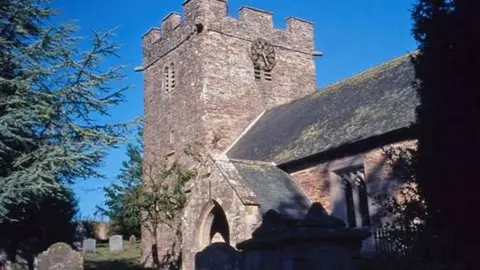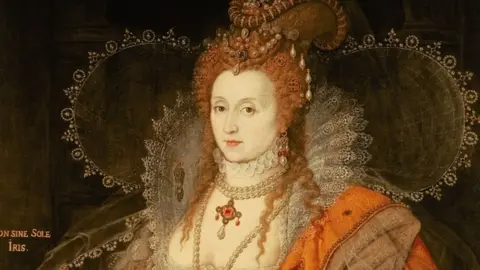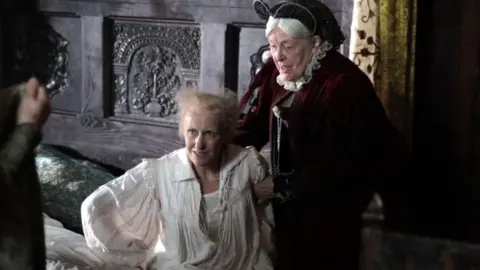Blanche Parry's life at the side of Queen Elizabeth I
 Pilley
PilleyBlanche Parry is one of history's most influential Welsh women, yet few know the name and only a handful know her story.
From her home on the Welsh marches she joined the Tudor court, nursing the young Princess Elizabeth and becoming a lifelong confidante who lived, breathed and slept alongside the Virgin Queen.
It is said Blanche, who spoke Welsh as her first language, would sing lullabies at the royal crib while in later life the pair would use Welsh words to disguise their discussions about courtiers and conspirators.
In a programme for BBC Radio Wales I have tried to uncover the truth about the role she played and how her strong Welsh credentials influenced Queen Elizabeth I during their long lives together.
The quest began in England, where the small parish of Bacton now sits in the Dore Valley. It is modern-day Herefordshire, some five miles (8km) from the Welsh border.
In the 16th Century this was Welsh-speaking Wales and it was where Blanche's ancestral seat at New Court would host the travelling bards and musicians who would tour the castles and country homes of the Welsh aristocracy.
These days New Court has gone, a vague outline among the trees at the valley edge is the only hint of its medieval presence.

Ruth Richardson, a former archaeology lecturer turned historian, has spent a decade tracing Blanche's steps from the Welsh borderland to the regal, ruthless Tudor court.
"I wanted to find out more about her. Nobody seemed to know anything about Blanche Parry; she was just consigned to the domestic sphere," she said.
Ms Richardson's cottage is filled with papers and books on the Elizabethan era, including her own published biography of Blanche, one of the only thorough accounts of the life of the little-known royal confidante.
"She's part of Elizabeth's household," Ms Richardson said.
"She takes over as the chief gentlewoman of the Privy Chamber. We also know that at one point when her sister Mary becomes Queen, Elizabeth is actually put in the Tower of London.
"And although Blanche isn't specifically named, Elizabeth is allowed to take one or two of her own ladies and Blanche would have been one of them."

But how did she become immersed in the royal household?
Blanche went from her home in Bacton to the Tudor court when Elizabeth was a young princess in the late 1530s. She joined her aunt, Lady Troy, who was already part of the entourage of a friend of Anne Boleyn.
While the Tudors' home life was anything but normal, it was Blanche and her aunt - two formidable Welsh women - who cared for the children.
"It's quite possible that those children actually learned or understood lullabies in Welsh," Ms Richardson said.
"Because these two Welsh ladies both had Welsh accents and they could well have sung Elizabeth to sleep with a Welsh lullaby."
The Welshness of Elizabeth's court would expand in later years and it is something reinforced for me by Eleri Lynn, the curator of historic dress for Historic Royal Palaces.
In the conservation studio at Hampton Court Palace she showed me the Bacton altar cloth, an elaborate piece of embroidered fabric that hung on the wall of St Faith's Church in Bacton until 2016 when Ms Lynn noticed it may be a rare piece of Tudor clothing.
In fact it is now confirmed to be the priceless sole survivor from Elizabeth's wardrobe, a cloth so lavish it is threaded with real silver and would have held the same value as a mansion in Tudor times.
"This is a unique survival of Elizabethan court dress," she said.
"In the world, there is no parallel to it. So, at the moment it is the only item of court dress that survives with such good provenance to Elizabeth I anywhere in the world.
"There are a few accessories that survive, such as boots and shoes, and a few smaller items. But nothing on this scale, and nothing of this craftsmanship and status."
The dress is now being prepared for an exhibition in 2019, but it was while researching Welsh characters in Elizabeth's court that Ms Lynn first came across Blanche and the cloth that hung in her parish church.

Ms Lynn, originally from Pontypool, Torfaen, said: "This story is just so Welsh in so many ways. The queen was only allowed to have clothes made by her designated dress-maker, because the court was very worried that gifts of poisoned dresses would make their way to the queen.
"And she only had two embroiderers and two dressmakers throughout her reign. They were very trusted and we know that at this time her dressmaker was a Welshman named William Jones."
But what of the talk that Elizabeth learned Welsh from Blanche?
"I would love to think that too, because Blanche was a Welsh speaker. She was 'Blanche, Ferch Harri' (Blanche, Daughter of Harry) and she had been with Elizabeth since she was an infant.
"So she might have heard some Welsh lullabies, but also the Tudor court was very fond of codes and secrets, and so it is very tempting to think that Blanche and Elizabeth might have spoken a little Welsh back and forth, a few code words or choice phrase perhaps, to say 'oh you can dismiss him', or 'bring that courtier forward'. Something that may have been a little code between them."
 Getty Images
Getty ImagesIt seems unsurprising Elizabeth would have kept a Welsh confidante, given her family background.
Ms Lynn explained: "Of course, Tudor is a Welsh name, so their ancestry is Welsh. There were notable Welsh courtiers, including William Cecil - Lord Burghley.
"Blanche Parry... was Elizabeth's closest companion, with her from cradle almost to grave. They were very close. Blanche even slept in the same bed as Elizabeth and was a second mother to her in many ways. Never married, she stayed by her side."
There have been few modern depictions of Blanche. One of the only portrayals of her on screen was by the Welsh actress Gwenyth Petty in a drama-documentary focusing on Elizabeth and the Spanish Armada.
It was speaking to Ms Petty at the time of her casting that prompted me to look further into the story of Blanche, who appeared to be a footnote in most accounts of the era.

 Ruth Richardson
Ruth RichardsonMs Richardson, who has devoted much of her retirement to uncovering the truth about Blanche, hopes more people will now celebrate the life of this influential woman.
"When I started looking at Blanche Parry I did it because she lived over there, near me. And I couldn't believe nobody had done it before.
"But to put her back centre stage, where she ought to be? It's just great."
- Queen's Confidante: The Story of Blanche Parry BBC Radio Wales, 18:30 GMT on 25 January and on BBC iPlayer
